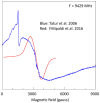Quantum Magnetism of the Iron Core in Ferritin Proteins-A Re-Evaluation of the Giant-Spin Model
- PMID: 38792115
- PMCID: PMC11123763
- DOI: 10.3390/molecules29102254
Quantum Magnetism of the Iron Core in Ferritin Proteins-A Re-Evaluation of the Giant-Spin Model
Abstract
The electron-electron, or zero-field interaction (ZFI) in the electron paramagnetic resonance (EPR) of high-spin transition ions in metalloproteins and coordination complexes, is commonly described by a simple spin Hamiltonian that is second-order in the spin S: H=D[Sz2-SS+1/3+E(Sx2-Sy2). Symmetry considerations, however, allow for fourth-order terms when S ≥ 2. In metalloprotein EPR studies, these terms have rarely been explored. Metal ions can cluster via non-metal bridges, as, for example, in iron-sulfur clusters, in which exchange interaction can result in higher system spin, and this would allow for sixth- and higher-order ZFI terms. For metalloproteins, these have thus far been completely ignored. Single-molecule magnets (SMMs) are multi-metal ion high spin complexes, in which the ZFI usually has a negative sign, thus affording a ground state level pair with maximal spin quantum number mS = ±S, giving rise to unusual magnetic properties at low temperatures. The description of EPR from SMMs is commonly cast in terms of the 'giant-spin model', which assumes a magnetically isolated system spin, and in which fourth-order, and recently, even sixth-order ZFI terms have been found to be required. A special version of the giant-spin model, adopted for scaling-up to system spins of order S ≈ 103-104, has been applied to the ubiquitous iron-storage protein ferritin, which has an internal core containing Fe3+ ions whose individual high spins couple in a way to create a superparamagnet at ambient temperature with very high system spin reminiscent to that of ferromagnetic nanoparticles. This scaled giant-spin model is critically evaluated; limitations and future possibilities are explicitly formulated.
Keywords: EPR; core; ferritin; giant spin; higher-order terms; metal-ion clusters; single-molecule magnets; spin Hamiltonian; superparamagnetism; zero-field interaction.
Conflict of interest statement
The author declares no conflict of interest.
Figures





Similar articles
-
Magnetic quantum tunneling: insights from simple molecule-based magnets.Dalton Trans. 2010 May 28;39(20):4693-707. doi: 10.1039/c002750b. Epub 2010 Apr 19. Dalton Trans. 2010. PMID: 20405069
-
Nitrogenase. VIII. Mössbauer and EPR spectroscopy. The MoFe protein component from Azotobacter vinelandii OP.Biochim Biophys Acta. 1975 Jul 21;400(1):32-53. doi: 10.1016/0005-2795(75)90124-5. Biochim Biophys Acta. 1975. PMID: 167863
-
In-depth magnetometry and EPR analysis of the spin structure of human-liver ferritin: from DC to 9 GHz.Phys Chem Chem Phys. 2023 Oct 18;25(40):27694-27717. doi: 10.1039/d3cp01358h. Phys Chem Chem Phys. 2023. PMID: 37812236 Free PMC article.
-
Coordination Clusters of 3d-Metals That Behave as Single-Molecule Magnets (SMMs): Synthetic Routes and Strategies.Front Chem. 2018 Oct 9;6:461. doi: 10.3389/fchem.2018.00461. eCollection 2018. Front Chem. 2018. PMID: 30356793 Free PMC article. Review.
-
Isotopic enrichment in lanthanide coordination complexes: contribution to single-molecule magnets and spin qudit insights.Chem Commun (Camb). 2023 Jul 6;59(55):8520-8531. doi: 10.1039/d3cc01722b. Chem Commun (Camb). 2023. PMID: 37335142 Free PMC article. Review.
References
LinkOut - more resources
Full Text Sources
Miscellaneous

